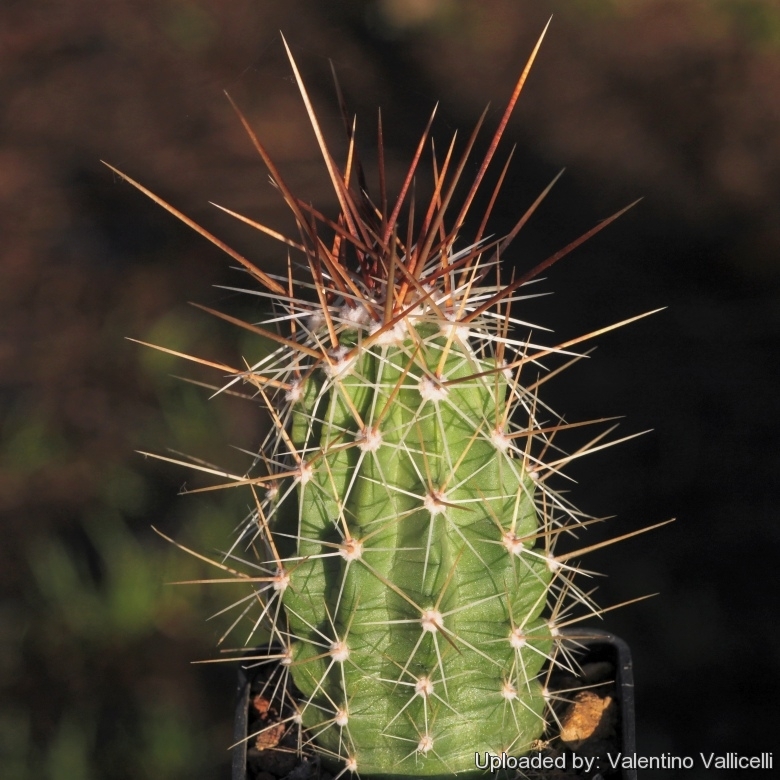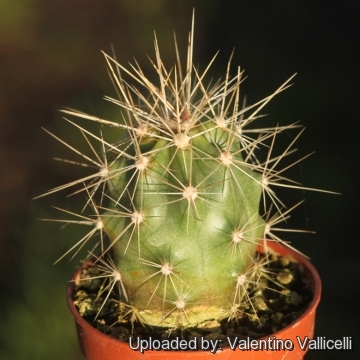Accepted Scientific Name: Echinocereus enneacanthus Engelm. in Wisliz.
Mem. Tour N. Mexico [Wislizenus] 111-112. 1848. Wisliz., Wisliz., Wisliz.

Echinocereus sarissophorus Photo by: Valentino Vallicelli
Origin and Habitat: Echinocereus sarissophorusSN|7934]]SN|7934]] is common in Coahuila and Chihuahua, Mexico.
Habitat: Gravel hills and benches, alluvial outwash fans and bolsones, also desert mountains, exposed to the sun or under shrubs.
Synonyms:
See all synonyms of Echinocereus enneacanthus
Common Names include:
ENGLISH: Pitaya hedgehog cactus, Purple pitaya, Alicoche, Purple Echinocereus, Pitahaya, Warty hedgehog, Pitaya, Strawberry hedgehog
Description: Echinocereus sarissophorusSN|7930]]SN|7934]] is a morphological form of the variable Echinocereus enneacanthusSN|7934]]SN|7930]] distinguishes for its stout, stubby habit and by its very long, usually stiff, often bluish spines. It is a particularly beautiful plant in flower. The differences with other “enneacanthus” are in reality very minimal (if none) and most botanist agree on the fact that “sarissophorus” should be included in the “enneacanthus”, and the two plants are not readily distinguishable, if not for the label.
Habit: Plants caespitose forming dense or lax clumps either loose decumbent, or erect, usually branching before flowering. Larger plants may have 50-100 or more stems.
Stems: Short, thick, pale green or somewhat yellow-green, about 10 cm thick and 15 cm long.
Ribs: 9 warty.
Areoles: that are 20-45 mm apart.
Radial spines: 7 to 10, slender.
Central spines: Several, 5 to 8 cm long, often bluish, somewhat angled, rather stout and divergent from the stem.
Flowers: Diurnal, funnelform, purplish, 7 to 8 cm long, and 7-9(-10) cm in diameter. Tepals in 2-3 series, inner ones broad oblanceolate up to 55 cm long and 1-2 cm wide, and acuminate-serrate at the apex; areoles on ovary and flower-tube bearing short, white wool and 3 to 5 long pale bristle-like spines.
Blooming season: Blooming in spring (April and May in habitat). Occasionally, plants produce single or a few flowers later in the year, possibly in autumn.
Fruit: Globular to ovoid, 2 to 3 cm. in diameter, covered with clusters of deciduous spines. The fruits are edible. After the spines are removed from the green-brown flesh of the fruit, it can be eaten and tastes similar to, hence the name strawberry cactus.
Seeds: Black, ovoid, tuberculate, and 1-1,4 mm long.
Chromosome number: 2n = 22.
Bibliography: Major references and further lectures
1) David Hunt, Nigel Taylor “The New Cactus Lexicon” DH Books, 2006
2) John Pilbeam (1999) “Mammillaria The Cactus File Handbook” Nuffield Press.
3) Nathaniel Lord Britton, Joseph Nelson Rose “Cactaceae: Descriptions and Illustrations of Plants of the Cactus Family” vol. 4 The Carnegie Institution of Washington, Washington 1923
4) Stuart Max Walters “The European Garden Flora: Dicotyledons (Part I)” Cambridge University Press, 1989
5) Edward F. Anderson “The Cactus Family” Timber Press, 2001
6) A. Michael Powell, James F. Weedin “Cacti of the Trans-Pecos & Adjacent Areas” Texas Tech University Press, 2004
 Echinocereus sarissophorus Photo by: Valentino Vallicelli
Echinocereus sarissophorus Photo by: Valentino Vallicelli Echinocereus sarissophorus Photo by: Valentino Vallicelli
Echinocereus sarissophorus Photo by: Valentino VallicelliCultivation and Propagation: Rot easily it is sensitive to overwatering (rot prone) needs a very good drainage to avoid rotting, Keep drier and cool in winter. Need full sun. Very cold resistant It can withstand freezing temperatures but not too much water (resistant to approx -12C or less for short periods of time)
Propagation: Cuttings that are left out to callus off before planting ; Also can be grown from seeds.












